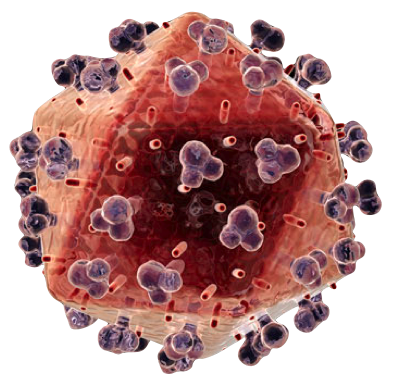It has been a long while since I blogged about anything, and it can be blamed perhaps on my teaching commitments, unfinished research papers and PhD students whose defence dates are up and the levels of stress are just a little more than anybody should have to deal with.
So it was with glee that I registered for a conference in Zuid Afrika (ZA) on bacterial virulence in November 2019 (BMSV, Cape Town) organized by a group of experts on Tuberculosis.
 |
| Yellow Fever Virus Particle: A rendering from RayUr.com |
Little did I know what extra adminisrative burden I was bringing onto myself. However, adding to my task-overload was the fact that I needed to prepare for the journey in a manner I had not so far required - vaccination! Indeed with all the strange rumour mongering about vaccines, it was surprising to come accross some clearly detailed list of places which if one transits or travels through, to re-enter India I will compulsorily need to be vaccinated against the Yellow Fever (1). To quote the site "Any person, Foreigner or Indian, (excluding infants below six months)
arriving by air or sea without a vaccination certificate of yellow fever
will be kept in quarantine isolation for a period up to 6 days if :
- He arrives in India within 6 days of departure/transit from a yellow fever endemic area.
- Has
come on a ship which has started from or transited at any port in a
yellow fever endemic country within 30 days of its arrival in India
provided such ship has not been disinfected in accordance with the
procedure laid down by WHO."
The insistence on "He" is theirs not mine. I would have preferred (the now archiac) s/he or even "Person(s)" to be gender neutral and non-binary.
The world health organization (WHO) describes the illness as an "...an acute viral haemorrhagic disease transmitted by infected mosquitoes...." (2) and the yellow-tag name comes from the fact that affected patients show jaundice (yellow) pallor. Jaundice in turns is a symptom of excess bilirubin in the blood, an effect of an underlying condition. The origins of bilirubin are of course the famed hemoglobin. The breakdown is described by the following (schematic) reactions (3,4):
Hb ----> Globin + Fe + Haeme
Haeme -----> Biliverdin -----> Bilirubin
The location of this degradation process is in the liver, spleen and bone marrow.
Thus the kind of infections that trigger excess breakdown of RBCs and Hb are grouped under haemolytic jaundice (as opposed to hepatic jaundice caused by liver dysfuntion कवेळी ).
To once more quote WHO, "The yellow fever virus is an arbovirus of the flavivirus genus and
is transmitted by mosquitoes, belonging to the Aedes and Haemogogus
species." In short it means transmission by mosquitoes and viral with surprisingly (acc. to WHO) no cure available, with help to prevent dehydration and liver failure improving patient outcomes (5).
Interesting the virus is a +ve sense ssRNA virus, i.e. its genome acts like an mRNA when it enters a host cell! The capsid structure of this Flavivirus (Latin "flavi" = yellow) is similar to that of the dengue and west-nile virus. Indeed endocytosis and ER targetting appear to be the modus operandi at the level of the single cell.
Much more remains to be done on this account, and perhaps as I expectantly wait for a jab, thoughts about potential engineering vaccines as opposed to the live, weakened virus that is currently administered (6).
So more to travelling scientists and spreading the good science, and better understanding the world around us.
References:
1) Bureau of Immigration, Govt. of India https://boi.gov.in/content/health-regulation
2) Yellow Fever, WHO https://www.who.int/news-room/fact-sheets/detail/yellow-fever
3) Hemoglobin catabolism and bilirubin http://chemistry.elmhurst.edu/vchembook/634bilirubin.html
4) Bilirubin Metabolism http://www.meddean.luc.edu/lumen/MedEd/orfpath/bilirub.htm
5) Yellow Fever Treatment https://www.who.int/csr/disease/yellowfev/en/
6) Yellow fever vaccine https://www.cdc.gov/vaccines/hcp/vis/vis-statements/yf.html







